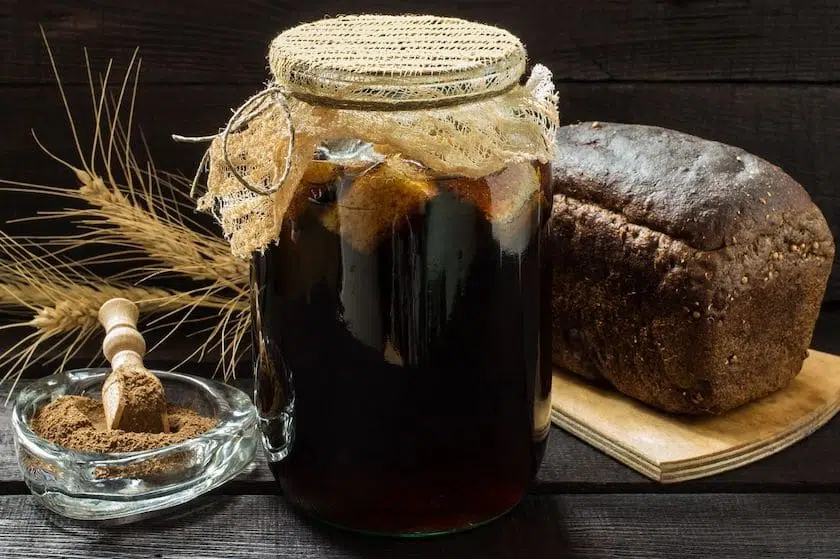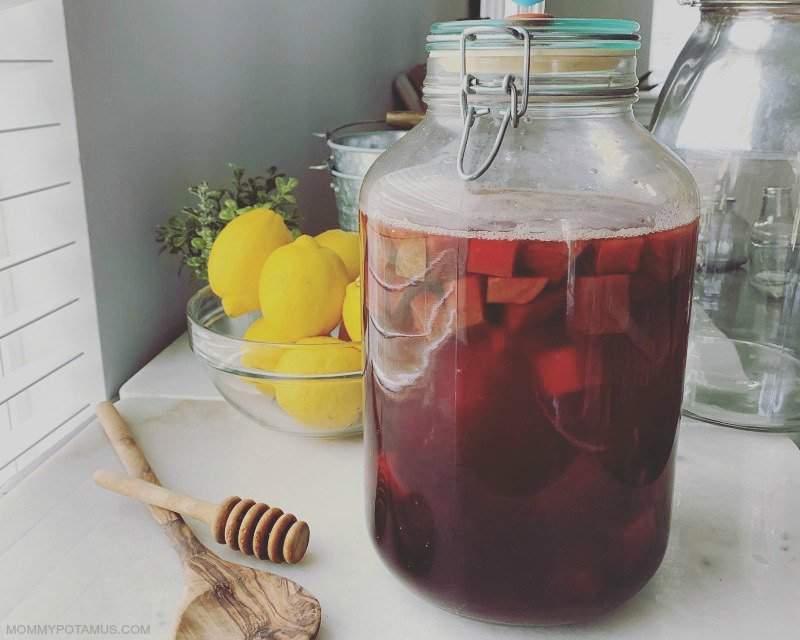Kvass, a traditional fermented beverage, has delighted palates for centuries. Its origins in Eastern Europe have spread far and wide, resulting in a diverse range of flavors and variations. Whether enjoyed as a refreshing drink, a culinary ingredient, or a cultural symbol, kvass holds a unique place in culinary history.
In this comprehensive guide, we’ll delve into the captivating world of kvass, exploring its rich history, brewing techniques, health benefits, cultural significance, and modern culinary applications. Join us as we embark on a journey to discover the secrets of this age-old beverage.
Definition of Kvass
Kvass is a fermented beverage traditionally made from rye bread, but it can also be made from other grains such as barley, oats, or wheat. It has a slightly sour and sweet flavor and is typically low in alcohol content.
Kvass is a popular drink in many Eastern European countries, particularly in Russia, Ukraine, and Belarus.
Origins and History
The origins of kvass are unclear, but it is believed to have been first brewed in Eastern Europe over 1,000 years ago. It was originally made from stale rye bread, which was fermented with water and yeast. Over time, kvass became a popular drink among the Slavic peoples and was often used as a substitute for beer.
In the 19th century, kvass began to be produced commercially, and it became widely available throughout Eastern Europe. Today, kvass is still a popular drink in many countries, and it is often served at festivals and celebrations.
Ingredients and Variations

Traditional kvass recipes call for a few essential ingredients:
- Bread: Rye bread is the most common type of bread used, but other types of bread, such as wheat or barley, can also be used.
- Water: The water should be clean and filtered.
- Sugar: Sugar provides the yeast with food to ferment.
- Yeast: Yeast is responsible for the fermentation process that gives kvass its characteristic fizziness.
There are many different types of kvass, each with its own unique flavor profile. Some of the most popular types of kvass include:
- Traditional kvass: This is the most basic type of kvass, made with rye bread, water, sugar, and yeast.
- Fruit kvass: This type of kvass is made with fruit juice or puree, which gives it a sweet and fruity flavor.
- Honey kvass: This type of kvass is made with honey instead of sugar, which gives it a slightly sweeter flavor.
- Beet kvass: This type of kvass is made with beets, which gives it a deep red color and a slightly earthy flavor.
Kvass recipes can also vary depending on the region or culture in which they are made. For example, in Russia, kvass is often made with black bread, while in Ukraine, it is often made with wheat bread.
Brewing Process
Brewing kvass involves a simple yet essential fermentation process that transforms the mixture of bread, water, and sugar into a refreshing beverage. Fermentation is the key to kvass’s unique flavor and health benefits.
To ensure optimal fermentation, maintaining the right temperature and pH level is crucial. Ideal fermentation temperatures range between 18-24°C (64-75°F), while the pH level should be around 4.5-5.5. Monitoring these conditions helps promote the growth of beneficial bacteria and yeast, which are responsible for converting the sugars into lactic acid and carbon dioxide.
Ingredients and Proportions
The proportions of ingredients used in kvass brewing can vary depending on personal preferences and desired sweetness levels. A common ratio is:
- 1 part rye bread (cut into small cubes)
- 1 part water
- 1/4 part sugar (or honey)
Additional ingredients, such as raisins, fruits, or herbs, can be added for flavor variations.
Fermentation Process
The fermentation process typically takes 3-7 days, depending on the desired tartness. The steps involved are:
- Combine the rye bread, water, and sugar in a large glass or ceramic container.
- Cover the container loosely with a cloth or cheesecloth and secure it with a rubber band.
- Store the container in a warm, dark place for 3-7 days, stirring occasionally.
- Once the kvass has reached the desired tartness, strain it into a clean container.
The resulting kvass can be enjoyed chilled or at room temperature. It can be stored in the refrigerator for up to 2 weeks.
Health Benefits
Kvass has been traditionally consumed for its purported health benefits. It contains beneficial compounds like probiotics, which support gut health, and other nutrients that may offer various advantages.
Probiotics and Gut Health
- Kvass is a natural source of probiotics, live microorganisms that benefit the gut microbiome.
- These probiotics help maintain a healthy balance of bacteria in the digestive tract, promoting overall digestive health.
- Probiotics may also help reduce inflammation, improve immune function, and lower the risk of certain chronic diseases.
Other Health Benefits
- Kvass is rich in B vitamins, essential for energy metabolism, nerve function, and red blood cell production.
- It contains antioxidants that may help protect cells from damage caused by free radicals.
- Kvass has been traditionally used to improve appetite, digestion, and overall well-being.
Cultural Significance

Kvass holds a profound cultural significance in various regions, deeply intertwined with local traditions, festivals, and social gatherings.
In Russia and Ukraine, kvass is an integral part of traditional cuisine and has been consumed for centuries. It is often served at festivals and celebrations, symbolizing hospitality and camaraderie. During the harvest season, kvass is brewed in large quantities and shared among families and communities, fostering a sense of unity and shared experience.
Kvass and Russian Culture
In Russia, kvass is considered a national beverage and is deeply rooted in the country’s history and culture. It is often associated with traditional Russian dishes such as borscht and pelmeni. Kvass is also a popular drink during the summer months, providing a refreshing and thirst-quenching beverage.
Kvass in Modern Cuisine
Kvass has found a niche in modern culinary applications, adding a unique flavor and tang to various dishes and beverages. Its versatility extends beyond traditional Slavic cuisine, with chefs and mixologists experimenting with kvass’s potential as a flavor enhancer and culinary ingredient.
Cocktails
Kvass has emerged as a distinctive base for cocktails, offering a refreshing and complex flavor profile. Bartenders craft innovative drinks that combine kvass with spirits like vodka, gin, or whiskey, adding a subtle sourness and earthy notes. The resulting cocktails are often garnished with herbs, citrus, or spices, complementing the kvass’s tangy character.
Marinades
Kvass’s acidic nature makes it an excellent marinade for meats, poultry, and fish. The enzymes in kvass tenderize the proteins, while the lactic acid adds a subtle sour flavor. Marinating in kvass infuses dishes with a unique umami quality and enhances their overall taste and texture.
Other Recipes
Kvass finds its way into a diverse range of culinary creations. Chefs use it as a base for soups, sauces, and dressings, adding a refreshing tang to these dishes. Kvass can also be incorporated into baked goods, imparting a subtle sourness and a distinctive flavor.
Its versatility makes it a valuable ingredient for culinary experimentation and innovation.
Closing Summary
From its humble beginnings as a peasant drink to its current status as a beloved beverage enjoyed worldwide, kvass has stood the test of time. Its versatility, health benefits, and cultural significance make it a true culinary gem. Whether you’re a seasoned brewer or a curious novice, we encourage you to experiment with this ancient recipe and create your own unique kvass.
Its refreshing taste and captivating history will surely leave a lasting impression.
FAQ Corner
What is the origin of kvass?
Kvass has a long history, dating back to ancient Slavic cultures in Eastern Europe. Its origins can be traced to the fermentation of rye bread, resulting in a slightly sour, effervescent beverage.
What are the health benefits of kvass?
Kvass is a good source of probiotics, which are beneficial bacteria that support gut health. It is also low in calories and contains vitamins and minerals, making it a healthy and refreshing alternative to sugary drinks.
How is kvass used in modern cuisine?
Kvass is finding new applications in modern cuisine. It is used as a marinade for meats, a base for cocktails, and even as an ingredient in baking. Its unique flavor profile adds a tangy, refreshing twist to various dishes.
